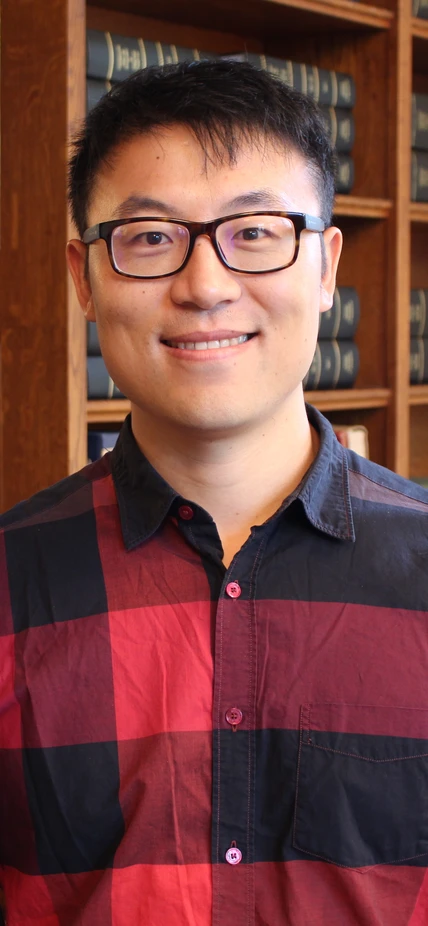Yanhao Lin finished up his postdoctoral position at the Earth and Planets Laboratory (EPL) in February 2021. While he was at EPL, Lin worked with Deputy Director Mike Walter to research how volatiles—chemical elements found in a planet’s interior like hydrogen and water—affect the interior dynamics of planets like the Moon, Mars, and Earth.
In a 2020 publication, Lin delved into the Earth’s deep water cycle. He was able to show that a mineral—stishovite—found in subducting oceanic plates may be able to hold water and transport it into the deep Earth when subjected to temperature and pressures of a planetary interior. This was a revelation because previously scientists thought stishovite was nominally anhydrous—it couldn’t hold much water. Based on his experiments, it looks like stishovite may be a key mineral for understanding how water cycles through our planet.
We caught Lin just before he left for a postdoc spotlight, please enjoy the interview below:
First, please introduce yourself and what you do here at EPL.
Hello all, I am Yanhao Lin. I began my science research in China, focusing on geology, and then moved to The Netherlands to expand my knowledge of planetary science. After earning my Ph.D. under the supervision of another former EPL (then Geophysical Lab) Postdoctoral Fellow Wim VanWestrenen, I moved to Washington, D.C. where I am currently a Postdoctoral Fellow at EPL, working with Dr. Michael Walter.
What are you currently researching?
My current research explores the deep water cycle in the Earth, the geophysical properties of Earth’s interior, and the interior structure of exoplanets that are enriched with SiO2 and water/ice.
Can you summarize your recent publication about the deep Earth water cycle? Why it is this important?
My major recent publication—Evidence for the stability of ultrahydrous stishovite in Earth’s lower mantle—demonstrated that a key mineral called stishovite—a high-pressure form of quartz and previously considered an anhydrous, dry mineral—is capable of storing large amounts of water in its crystal structure even under extreme conditions, like those found in Earth's lower mantle.
The great abundance of water on Earth’s surface makes it different from other terrestrial planets, and it may be linked to a deep interior water cycle. How water is transported into Earth’s deep interior and in which phases it is held are still a matter of debate.
What we do know is stishovite is a major component of subducted oceanic basalt, and my work indicates that—at the pressure–temperature conditions of a mantle—stishovite may be a key phase for transporting water into the deep mantle, providing important information on the water cycle in the deep earth, and indicating that a whole-mantle water cycle occurring on very long geologic time scales is possible.
What inspired you to choose this field of study?
Interest! I first experimentally quantified water content in the early Moon and investigated how water significantly affected the lunar magma ocean evolution during my Ph.D.
An important aspect that increased my curiosity was how water is transported into the deep Earth. The diamond anvil cell (DAC) is an essential high-pressure technique for exploring this question, which was a totally new technique to me before my Postdoc at the Carnegie Earth and Planets Lab. I am quite lucky to get an opportunity to learn this DAC technique at Carnegie and use it to investigate the deep water cycle.
How has your background influenced your research?
My combined interest and educational background in both geology and planetary science really influence my current research. I am able to pull knowledge from both fields and try to see ideas from a unique perspective.
What else has influenced your thinking as a scientist?
I am lucky to have had great supervisors and mentors encourage me along the way. They have influenced me to be patient and persistent, both traits I strive for in all aspects of life. Their encouragement continues to inspire my interests in planetary science, experimental petrology, and high-pressure science.
When you’re not actively researching, what hobbies or activities do you enjoy in your spare time?
Spare time? We have a toddler and a new baby, keeping us busy! We enjoy going to local parks and walks in the community with the girls. But, I do try to make it to the gym regularly, it’s where I do lots of creative thinking. Family dinners are also one of the best parts of our day.
Why did you choose Carnegie’s Earth and Planets Laboratory?
Excellent scientific research atmosphere, world-class scientists, top research equipment and support, and great location!
What are you planning to do after your time at EPL?
After my postdoc at EPL, I will join the Center for High-Pressure Science and Technology Advanced Research (HPSTAR), Beijing as a staff scientist, and will continue to investigate the volatile evolution and its effects on the planets through high-pressure experiments.
